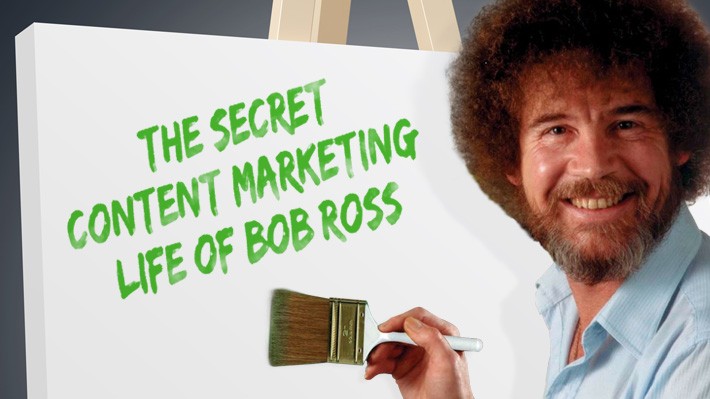The secret content marketing life of Bob Ross
For most of the 1980s and early 1990s, the best-known and most popular contemporary painter in America wasn’t Andy Warhol, Jean-Michel Basquiat, Keith Haring or any of the other celebrated artists of the period. It was Bob Ross.
Ross presented his show The Joy of Painting on PBS, the country’s publicly funded broadcast network, from 1983 to 1994, as famous for his soothing voice, open-necked shirts and distinctive afro as the mountains and trees that he put onto canvas. Everyone thought they knew this gentle oil painting instructor, publicising a ‘wet on wet’ painting technique that could help them to create a stunning painting in less than an hour – and that sense of connection has grown ever since. He may have died of lymphoma in 1995, shortly after the illness forced his retirement from presenting, but Bob Ross’s profile has only kept increasing since. Today, he’s a full-blown internet sensation. The Joy of Painting episodes are some of the most popular content on YouTube today. They’ve been affectionately parodied in a trailer for Deadpool 2. They’re enough to stop a rock band on tour in their tracks, ready to put everything else aside to listen to how to paint an Alaskan landscape.
What most of the millions of Bob Ross fans past and present don’t know is that this genial artist and public broadcasting institution had a secret. It’s a secret so shocking that it led to disbelief and soul-searching debate on social media platforms when my friend Scott Stratten unearthed it in his recent book Unbranded.
Bob Ross was a content marketer. In fact, he was arguably the most brilliantly successful content marketer in history. He wasn’t being paid by PBS to make his iconic broadcasts. He didn’t need to ask for a dime, because he’d created the show itself in order to build his own business – and throughout that decade on air, he was calmly and quietly crafting a $15 million art supplies empire ($30 million at today’s values). He became a multi-millionaire with hardly anybody realising that he was selling to them at all.
People can quibble about the artistic merits of Bob Ross’s paintings (and plenty of serious artists at the time did exactly that). They can point out that his painting style wasn’t even his own (he’d learned it from his one-time painting instructor William Alexander). But nobody can argue for a moment about just how original, insightful and ahead of his time Bob Ross was as a content marketer. He laid down principles of engaging and selling through content that marketers are only just rediscovering today. He may not have been a Caravaggio, Rembrandt or Vermeer – but he was the undisputable Old Master of his particular commercial craft.
This is the real story behind Bob Ross and The Joy of Painting – seven lessons that any content marketers should seek to apply to their own art:
The value in the product inspires the value in the content
The art supplies business Bob Ross Inc. wasn’t an opportunist spin-off leveraging Ross’s TV fame. He’d already founded it, selling the paints required to copy the “wet on wet” technique that he’d learned, and running painting classes to promote his supplies. It was a student in one of those classes, Annette Kowalski, who urged him to get on TV. She saw that the real value Bob Ross had to offer wasn’t contained in a tube or a brush: it was the enjoyment that came out of those things, an enjoyment he had a unique gift for communicating. The Joy of Painting was designed from the outset to fill this gap: to engage people with the emotional value of painting like never before.
Learn the expertise – then give it your own spin
Just because your ideas aren’t completely new doesn’t mean that you can’t bring them to audiences in a way that’s original, fresh and authentic. Bob Ross didn’t invent his famous “wet on wet” technique of applying a lair of white paint to a canvas, and then adding coloured oils on top. He copied it from Alexander, who had himself copied it from 16th century painters. However, the gentle, sonorous, rolling delivery, the passion for nature and the attitude to life (“there are no mistakes, just happy accidents”) were his own. Bob Ross brought verve, style and creativity to how he communicated the techniques he chose to build a business on. This ensured those ideas reached an audience that would otherwise never have encountered them.
Lead with the audience benefit
The most successful Sponsored Content in the LinkedIn feed is the content that signals a compelling benefit to the audience from engaging with it. That’s something Bob Ross instinctively understood. The entire format of The Joy of Painting held a promise to the audience: it started out with a blank canvas, which 30 minutes later would be filled with a painting. Follow Bob’s steps in real time and you could create that landscape for yourself. Art had never appeared more accessible.
Become the media if you have to
For all of this to work though, Bob Ross first had to get onto TV – and Kowalski had an idea for how he could do so. The two created an ad to air during an episode of The Phil Donahue show that was designed to demonstrate Ross’s unique presenting style and the value that he could offer through content. They started out by funding their own media in order to secure the organic distribution that would take them mainstream. There was a gap in the PBS schedules for an art instruction show – and Bob Ross demonstrated that he was the one to fill it.
Focus on the solutions not the product
Why did so few people spot the business model behind Bob Ross’s TV show? Because he spent so little time talking about the products his business sold. Ross mentioned the names of his bespoke, branded paints (“Liquid White”, “Dark Sienna”) as he applied them to a canvas, but he never laboured the point about why they were special or what they could do. He motivated the audience by demonstrating what they could create: showing the solution rather than discussing the product.
Never sacrifice credibility for quick sales
Another distinct characteristic of Ross’s approach to content marketing was a determination never to over-sell. He advised using his paints sparingly, declaring that a can of liquid white should last a lifetime, for example. Why? Because he knew that the end results would be better and his credibility as a content provider was far more important than the uplift in sales he’d gain from persuading audiences to use more of his product unnecessarily.
Leverage partnerships and platforms as they emerge
It’s amazing how many people of my generation were first introduced to Bob Ross through MTV. Ross jumped at the chance to record some idents for the music channel when it first launched, and found his popularity growing exponentially as an audience growing up on hair metal suddenly encountered his unique, down-home style. It wasn’t the first time that he’d embraced new platforms or partnerships as a means of spreading the word around his brand and products. He’d already recorded live shows with Joan Rivers and daytime TV hosts Regis and Kathie Lee, and taught Phil Donahue (whose airtime he’d bought to launch his TV career) to paint on screen. Having built a unique and uniquely powerful content brand, Bob Ross knew exactly how to leverage it – and he was hugely enthusiastic about using new and emerging platforms to do so. It’s a massive pity that he didn’t live to see his content dominating YouTube – because I’m convinced he’d have gotten a massive kick out of it. We’d probably still be learning from him about how to leverage technology like VR and 360 video today.
Related articles



